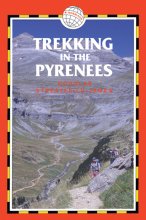Guides that will send you packing.
— Today

Trekking in the Pyrenees
Excerpt:
Planning your trek
Contents List | Introduction | Route options | Planning your trek | Eating and Drinking - Pyrenean Style | Sample Trek

INDEPENDENT TREKKING
Off the beaten track
If you're an experienced mountain trekker, and enjoy long days through deserted valleys, you'll find plenty of memorable treks in the Pyrenees. In order to get away from the crowds, you'll have to venture a little off the beaten track but within a relatively short distance there are some wonderful places to discover. Miles into the mountains, you can pitch your tent amidst magnificent scenery and if you are lucky have the place all to yourself in the morning. There can be disadvantages: camping can be miserable in poor weather, and what with food, cooking gear and a tent, you'll have to carry much more in your rucksack. For most trekkers, however, the effort is amply repaid.
Independent trekking via g�tes d'�tape & refuges
If the thought of spending your holiday hauling a huge backpack around the mountains doesn't appeal, fear not. There are enough facilities along the major paths to bring independent trekking within the reach of everyone. From early June to late September the main routes through the Pyrenees are well served by g�tes d��tape (lodges) and refuges (mountain huts), where food and accommodation are available. If you use these throughout your trip, you can cut down substantially on the amount of kit you need to carry – a light sleeping bag is all that is needed for overnight gear. Quite apart from lightening the load, there are other perks: a hot shower at the end of the day, delicious local food, and even cold beer.
Staying in lodges is obviously more costly than camping, and it's less flexible, too. There may be occasions in peak season when you have to adjust your plans in order to be sure of having somewhere to stay. In two or three areas along the GR10 and several sections of the GR11 where no accommodation is available, walkers are forced either to camp or make use of cabanes (shepherds’ huts). These areas, almost entirely towards the eastern end of the range, are clearly marked in the book.
GROUP TOURS AND GUIDED WALKS
The decision of whether or not to trek with an organized group may rest on several factors, but if you enjoy the company of other people and would prefer to leave the route planning to someone else, a group walking holiday may be for you. There can be great advantages in joining a group: you may, for example, have specialist guides who can point out local flora and fauna. These are often local people who can tell you about the area you are passing through, and groups that are led by professional mountain guides may be able to follow a mixed itinerary of trekking and other adventurous activities such as rafting or climbing. On the mundane side, if you are going with friends whose stamina and trekking skills vary, the provision of transport ensures that the slower ones can take a break while the rest enjoy a full itinerary. Trekking companies offer various permutations: you can be part of a large or small group; you may be accompanied by a guide throughout the day or simply pointed in the right direction to enjoy the walk by yourself.
The drawback in taking a guided walking holiday is that you may find yourself tied to a fixed itinerary and to a large group of other people. An alternative to being part of a group is to get a trekking company to tailor an itinerary just for you. Several companies do this and will make bookings for all transport and accommodation in advance of your arrival.
Trekking in the Pyrenees
Excerpts:
- Contents List
- Introduction
- Route options
- Planning your trek
- Eating and Drinking - Pyrenean Style
- Sample Trek
Latest tweets